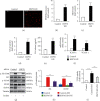Heat Shock Protein 70 Mediates the Protective Effect of Naringenin on High-Glucose-Induced Alterations of Endothelial Function
- PMID: 35958293
- PMCID: PMC9359828
- DOI: 10.1155/2022/7275765
Heat Shock Protein 70 Mediates the Protective Effect of Naringenin on High-Glucose-Induced Alterations of Endothelial Function
Abstract
Endothelial dysfunction plays a pivotal role in the development and progression of diabetic vascular complications. Naringenin (Nar) is a flavanone bioactive isolated from citrus fruits known to have in vitro and in vivo antidiabetic properties. However, whether Nar affects endothelial function remains unclear in diabetes or under high-glucose (HG) condition. Using an in vitro model of hyperglycemia in human umbilical vein endothelial cells (HUVECs), we found that Nar administration markedly attenuated HG-induced alterations of endothelial function, evidenced by the mitigation of oxidative stress and inflammation, the reduction of cell adhesion molecular expressions, and the improvement of insulin resistance. We also found that HG exposure significantly reduced the levels of intracellular heat shock protein 70 (iHSP70 or iHSPA1A) and the release of HSP70 from HUVECs. HSP70 depletion mimicked and clearly diminished the protective effects of Nar on HG-induced alterations of endothelial function. In addition, Nar treatment significantly enhanced iHSP70 protein levels through a transcription-dependent manner. These results demonstrated that Nar could protect HUVECs against HG-induced alterations of endothelial function through upregulating iHSP70 protein levels. These findings are also helpful in providing new therapeutic strategies that are promising in the clinical use of Nar for the treatment of diabetes and diabetic complications.
Copyright © 2022 Zhihan Zhang et al.
Conflict of interest statement
The authors declare that they have no conflicts of interest regarding the publication of this paper.
Figures






Similar articles
-
Naringin inhibits autophagy mediated by PI3K-Akt-mTOR pathway to ameliorate endothelial cell dysfunction induced by high glucose/high fat stress.Eur J Pharmacol. 2020 May 5;874:173003. doi: 10.1016/j.ejphar.2020.173003. Epub 2020 Feb 8. Eur J Pharmacol. 2020. PMID: 32045600
-
Naringin inhibits lipopolysaccharide-induced damage in human umbilical vein endothelial cells via attenuation of inflammation, apoptosis and MAPK pathways.Cytotechnology. 2016 Aug;68(4):1473-87. doi: 10.1007/s10616-015-9908-3. Epub 2016 Mar 23. Cytotechnology. 2016. PMID: 27006302 Free PMC article.
-
Hydrogen Sulfide Protects Against High Glucose-Induced Human Umbilical Vein Endothelial Cell Injury Through Activating PI3K/Akt/eNOS Pathway.Drug Des Devel Ther. 2020 Feb 14;14:621-633. doi: 10.2147/DDDT.S242521. eCollection 2020. Drug Des Devel Ther. 2020. PMID: 32103904 Free PMC article.
-
Could Naringenin Participate as a Regulator of Obesity and Satiety?Molecules. 2023 Feb 2;28(3):1450. doi: 10.3390/molecules28031450. Molecules. 2023. PMID: 36771113 Free PMC article. Review.
-
New insights into the role and therapeutic potential of HSP70 in diabetes.Pharmacol Res. 2022 Apr;178:106173. doi: 10.1016/j.phrs.2022.106173. Epub 2022 Mar 9. Pharmacol Res. 2022. PMID: 35278625 Review.
Cited by
-
Atheroprotective Aspects of Heat Shock Proteins.Int J Mol Sci. 2023 Jul 21;24(14):11750. doi: 10.3390/ijms241411750. Int J Mol Sci. 2023. PMID: 37511509 Free PMC article. Review.
-
Research Progress of Flavonoids Regulating Endothelial Function.Pharmaceuticals (Basel). 2023 Aug 23;16(9):1201. doi: 10.3390/ph16091201. Pharmaceuticals (Basel). 2023. PMID: 37765009 Free PMC article. Review.
References
-
- Shi Y., Vanhoutte P. M. Macro- and microvascular endothelial dysfunction in diabetes. Journal of Diabetes . 2017;9(5):434–449. - PubMed
-
- Wołoszyn-Durkiewicz A., Myśliwiec M. The prognostic value of inflammatory and vascular endothelial dysfunction biomarkers in microvascular and macrovascular complications in type 1 diabetes. Pediatric Endocrinology, Diabetes and Metabolism . 2019;25(1):28–35. - PubMed
LinkOut - more resources
Full Text Sources

